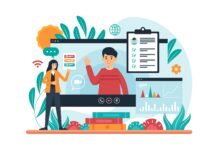Over the last two years, as living rooms and kitchens became classrooms, teachers and students around the world adjusted their lives to remote learning. According to weforum.org, there was already high growth and adoption in education technology, with global edtech investments reaching $18.66 billion in 2019 and the overall market for online education projected to reach $350 billion by 2025.
We have witnessed a lot of apprehensions when it comes to integrating and leveraging technology into the classroom. Either it is viewed as a boon or as a threat, leading to mistrust and rejection. However, in reality, technology when deployed with an open mind can be a tremendous ally for teachers and educators as well as a catalyst for change. It has the potential to transform education if used by teachers who are willing to create engaging and effective learning experiences for their students.
Owing to the increased using of tech in classrooms, teachers are now able to delegate mundane tasks and focus more on engaging with students to enhance the learning process. To effectively support teachers to improve student engagement and learning, teacher’s education programs may want to address the development of these competencies. As a result of this, teachers can go far beyond just imparting education by using insights to mould experiences for their students’ benefit.
Effective use of digital learning tools in classrooms can improve student engagement, assist teachers with better lesson plans, and promote customized instruction. Teachers can leverage technology to reach new levels of productivity, deploy helpful digital tools to increase students learning opportunities and improve support and engagement among students. Technology can simplify how instructional designers gather data about students’ learning and engagement when they engage with digital tools, yielding valuable insights that are otherwise difficult to obtain in distance-learning environments. Technology can enhance learning experiences for students and teachers alike, with customization. By using technology, teachers not only have access to tools that can create individualized instruction for each learner, but they can also free up time for themselves to focus on scheduling, sharing instruction with peers, and lightening the load. With the right technologies, teachers can get back up to 30% of their time, which they can use for personalized instruction that will increase their student’s opportunities.
Technology is empowering educators at all levels, enabling them to build lessons that reach not only small classes, but thousands of students distributed across the globe. As you can see, using technology to expand student opportunities within a classroom is essential if we are going to build a passionate workforce. Technology in the classroom has made learning from students as accessible as ever, giving students a sense of ownership over their learning.
Top Courses in Personal Development
Efficient use of technology is one of the key principles to ensuring the creation of effective teachers. In particular, deeper learning occurs when districts, schools, and classroom leaders prioritize and invest in using technology as a tool for deepening student-teacher learning and engagement in dynamic classroom settings, not just building students’ capacity for using technology themselves. Technology must be viewed as a tool to accomplish a goal rather than as a goal itself. It must be utilized as a tool that can provide value and that adjusts to the teacher’s chosen pedagogical approach and curriculum.
Attributed to Mr. Harshil Gala, CEO, NAVNEET TOPTECH
Visit EasyShiksha for new updates







































































